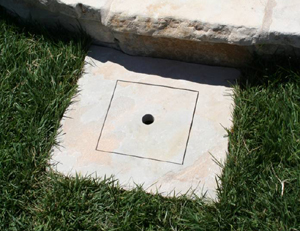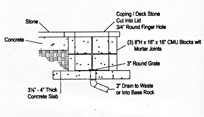Cool Sensations
By Paolo Benedetti
 As I've emphasized so far in this series on the art of concealment, it is my firm belief that, as a designer and/or builder, you must pay attention to detail if your goal is to reduce visual clutter and thereby please your clients.
As I've emphasized so far in this series on the art of concealment, it is my firm belief that, as a designer and/or builder, you must pay attention to detail if your goal is to reduce visual clutter and thereby please your clients.
In my own projects, I am so accustomed to pushing past so many aesthetic obstacles that it's become second nature to me. As a result, whenever the need arises to install, say, a junction box or a deck drain or a cleanout, I have a number of possible solutions in mind right from the start.
But not all of the project features that may need hiding are required functional elements or components whose use is a matter of code. In some cases, in fact, these are neat touches and details that are wholly unnecessary but whose very inclusion is made possible by the fact that they can be artfully hidden from view.
Good Times
A case in point: I live and work in an area where the summer temperatures often reach the triple digits, meaning hydration is an issue even when my clients are relaxing in or beside a pool or spa. To accommodate this need, one of the nicer extras I've worked with through the years has to do with hiding an ice chest at a handy spot in the deck.
 It's pretty straightforward: After I ask my clients what they want to stow in an ice chest (a key to determining how deep the container should be, particularly if they want to keep champagne or wine bottles on ice), we select some sort of liner. Cinder blocks (Figure 1) or even a big plastic bucket will do, although some of my clients have asked me to form them in concrete. We set up a drain so the melting ice has a place to go, then top the container with the same material as the surrounding decking (Figure 2).
It's pretty straightforward: After I ask my clients what they want to stow in an ice chest (a key to determining how deep the container should be, particularly if they want to keep champagne or wine bottles on ice), we select some sort of liner. Cinder blocks (Figure 1) or even a big plastic bucket will do, although some of my clients have asked me to form them in concrete. We set up a drain so the melting ice has a place to go, then top the container with the same material as the surrounding decking (Figure 2).
 The cover and surrounding soil act as reasonable insulators, so the ice lasts a good, long time. Moreover, the amount of water from the melting ice is negligible - so limited, in fact, that all I install in many cases is a drain grate in the bottom of the housing that allows water to flow out and percolate into a layer of crushed rocks or directly into the soil.
The cover and surrounding soil act as reasonable insulators, so the ice lasts a good, long time. Moreover, the amount of water from the melting ice is negligible - so limited, in fact, that all I install in many cases is a drain grate in the bottom of the housing that allows water to flow out and percolate into a layer of crushed rocks or directly into the soil.
The best thing is that when this particular amenity isn't being used, it's completely hidden  from view with the modest exception of the lifting holes (Figure 3). There's really no limit to what you can do with these ice chests. I've even built large concrete boxes in raised planter beds to house multiple cases, although in these cases the lids need to be segmented to make them more manageable. And to make large chests even more convenient, I've sometimes provided my clients with wooden lids that can be used during parties - one way to make certain mishandling won't damage stone lids. For clients who hold large, frequent parties, I've installed multiple hidden ice chests to keep crowds from congregating in just one refreshment area.
from view with the modest exception of the lifting holes (Figure 3). There's really no limit to what you can do with these ice chests. I've even built large concrete boxes in raised planter beds to house multiple cases, although in these cases the lids need to be segmented to make them more manageable. And to make large chests even more convenient, I've sometimes provided my clients with wooden lids that can be used during parties - one way to make certain mishandling won't damage stone lids. For clients who hold large, frequent parties, I've installed multiple hidden ice chests to keep crowds from congregating in just one refreshment area.
As I see it - and as my clients lead me to believe - the benefits of these inexpensive ice chests is that they eliminate the need to have unsightly plastic ice chests sitting on the pool deck. Not only does this get rid of some visual noise, but it also leaves more deck space open for traffic, socializing or chairs. And there's no need to clean, dry out or stow anything after a party.
In my view, these receptacles are just the sort of detail that increases my clients' chances of getting more enjoyment from their watershapes. And the fact that they can be accomplished using the art of concealment only makes it more satisfying.
